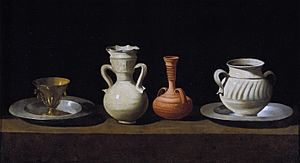Still Life with Pots facts for kids
Still Life with Pots is the name of two paintings created in 1650 by the famous Spanish artist Francisco de Zurbarán. These paintings show everyday objects like pots and cups, arranged carefully. One of these original paintings is now kept at the Museo del Prado in Madrid, Spain. It was given to the museum in 1940 by a collector named Francesc Cambó. He also owned a second version of the same painting, which you can now see at the National Art Museum of Catalonia in Barcelona.
Contents
What is a Still Life Painting?
A still life painting is a type of art that shows objects that are not alive. These can be things like fruit, flowers, food, books, or kitchen items. Artists arrange these objects in a special way to create a scene. Still life paintings let artists show off their skills in painting textures, light, and shadows. They can make everyday items look beautiful and interesting.
The History of Still Life Art
Still life art has been around for a very long time. Ancient Egyptians and Romans painted still life scenes on walls and tombs. During the 17th century, when Zurbarán was painting, still life became very popular in Europe. Artists in countries like Spain and the Netherlands painted many detailed still life works. These paintings often had hidden meanings or symbols.
About the Artist: Francisco de Zurbarán
Francisco de Zurbarán (1598–1664) was a very important Spanish painter during a time known as the Spanish Golden Age. He was born in a small town in Spain and later moved to Seville, a big city, to become an artist. Zurbarán was known for his religious paintings, especially those showing monks and saints. He was also very good at painting still life scenes.
Zurbarán's Painting Style
Zurbarán's style is often described as realistic and dramatic. He used strong contrasts between light and shadow, a technique called chiaroscuro. This made his paintings look very powerful and deep. In his still life works, he focused on showing the simple beauty of ordinary objects. He painted them with great detail, making them seem almost real. His paintings often have a quiet and calm feeling.
The Still Life with Pots Paintings
The two Still Life with Pots paintings are great examples of Zurbarán's skill. They show a few simple clay pots and cups arranged on a shelf. The light falls on the objects in a way that highlights their shapes and textures. You can almost feel the rough surface of the clay.
Why These Paintings Are Special
These paintings are special because they show how an artist can make simple objects look grand. Zurbarán didn't just paint pots; he painted the light, the shadows, and the quiet dignity of these everyday items. They are also important because they are among the few still life paintings that Zurbarán created. Most of his work was religious. The fact that there are two versions shows that the painting was popular, and the artist might have made a copy for another buyer.
Where to See the Paintings
Today, you can see one version of Still Life with Pots at the Museo del Prado in Madrid. This museum is one of the most famous art museums in the world. The other version is at the National Art Museum of Catalonia in Barcelona. Both museums are great places to learn about Spanish art history.
See also
 In Spanish: Bodegón con cacharros (Zurbarán) para niños
In Spanish: Bodegón con cacharros (Zurbarán) para niños


